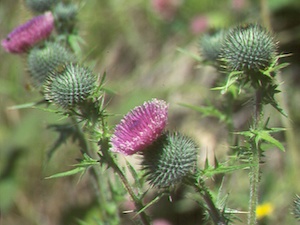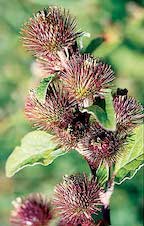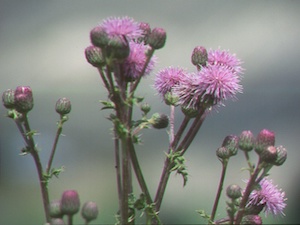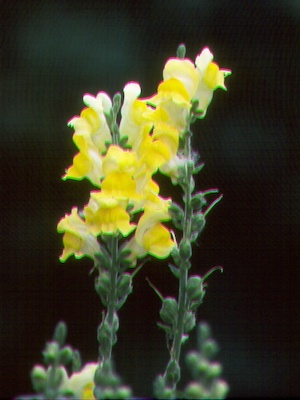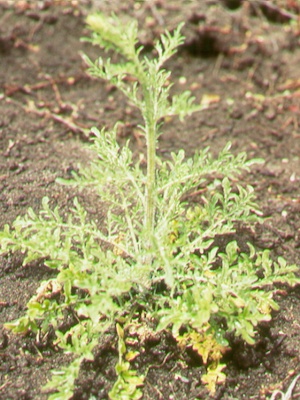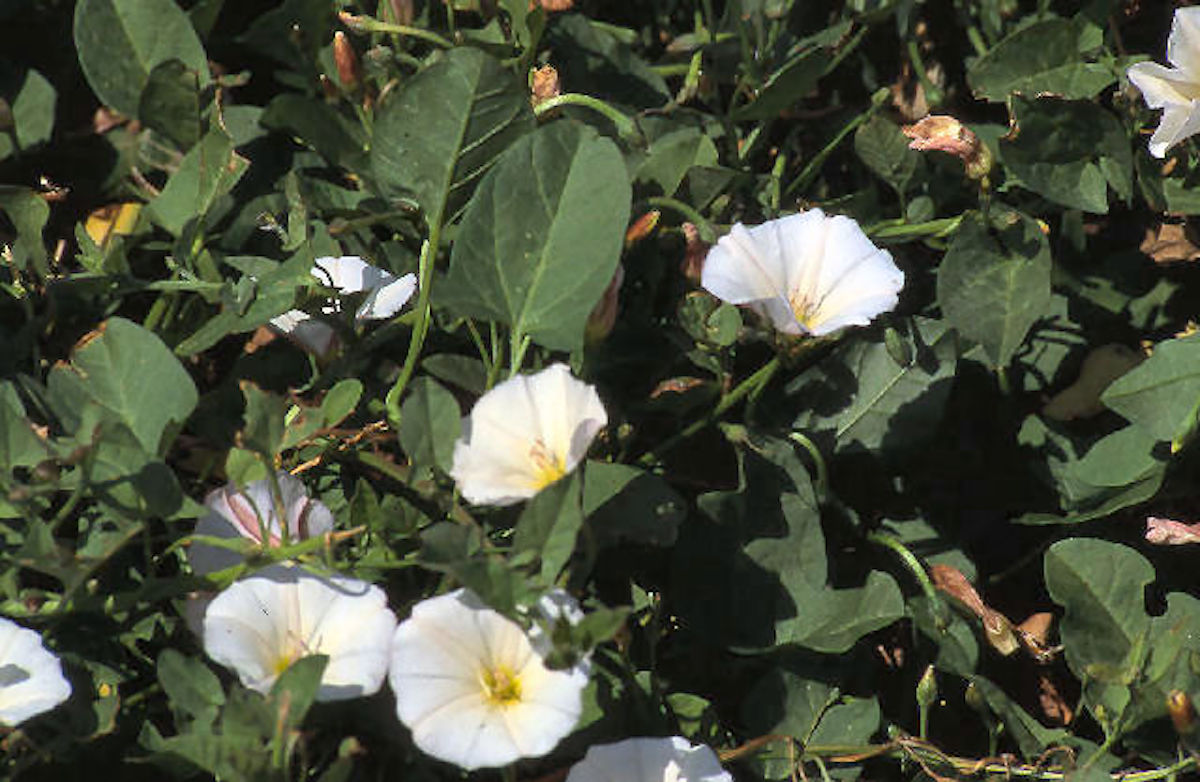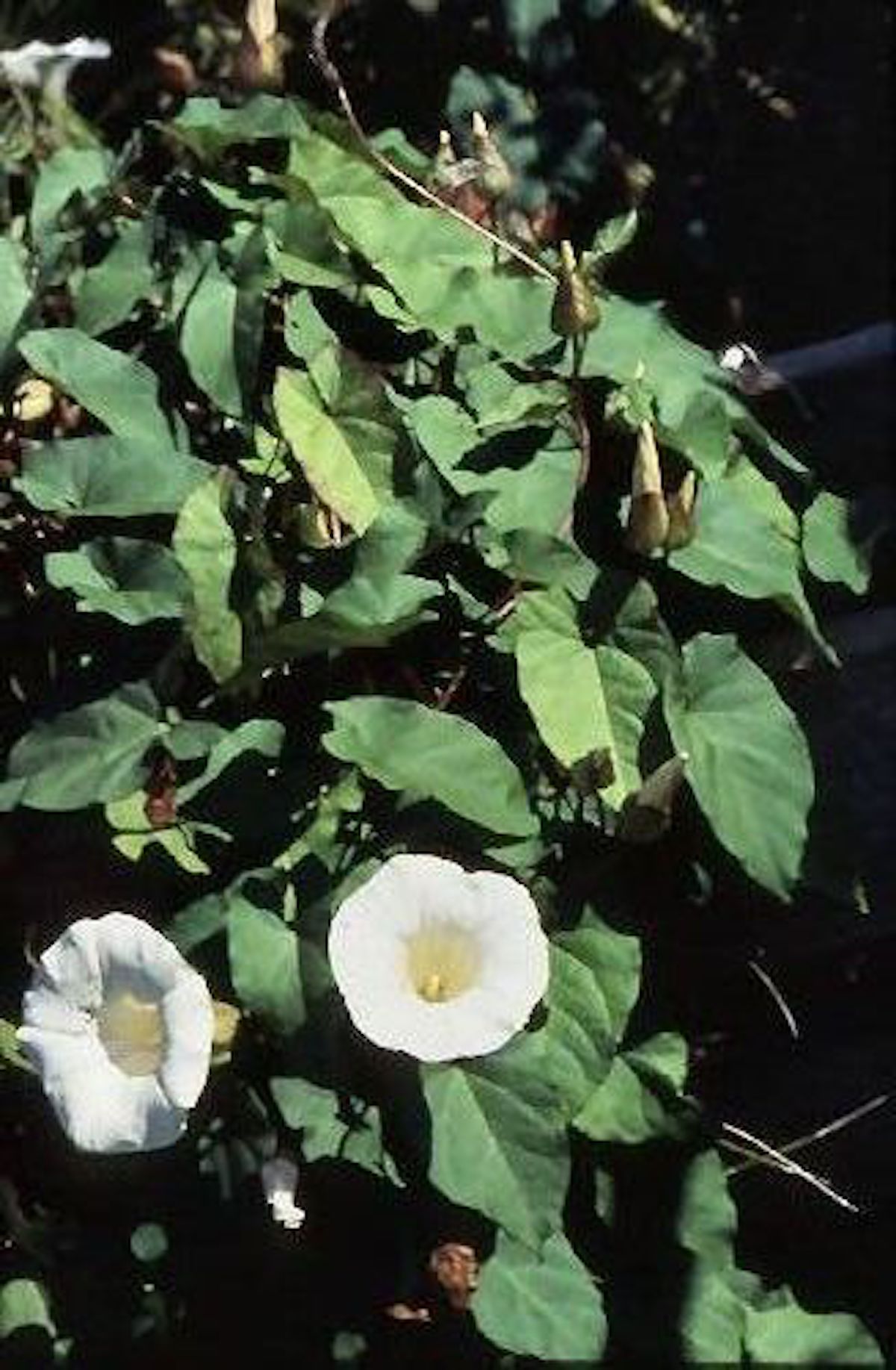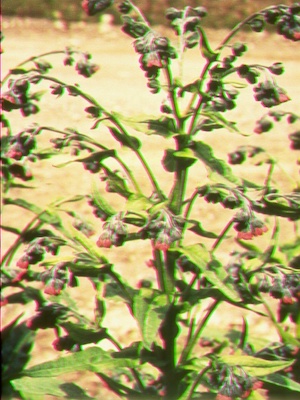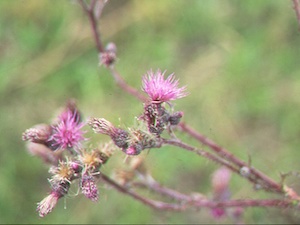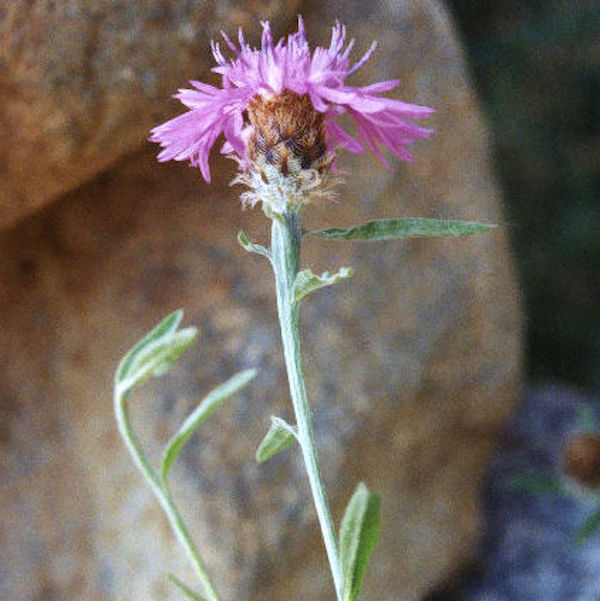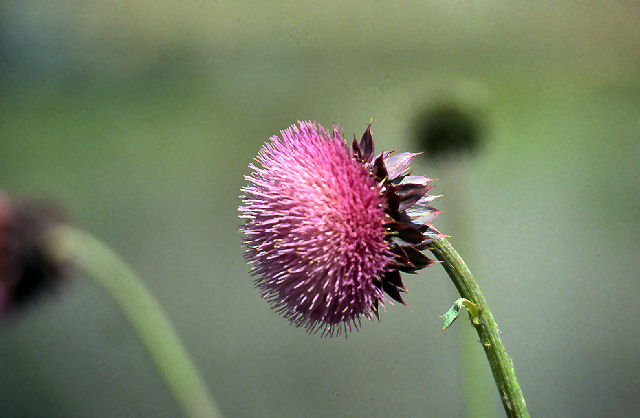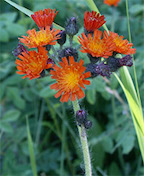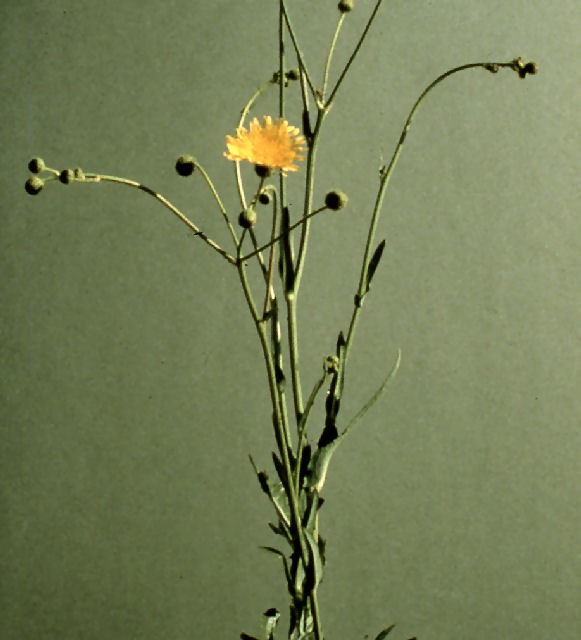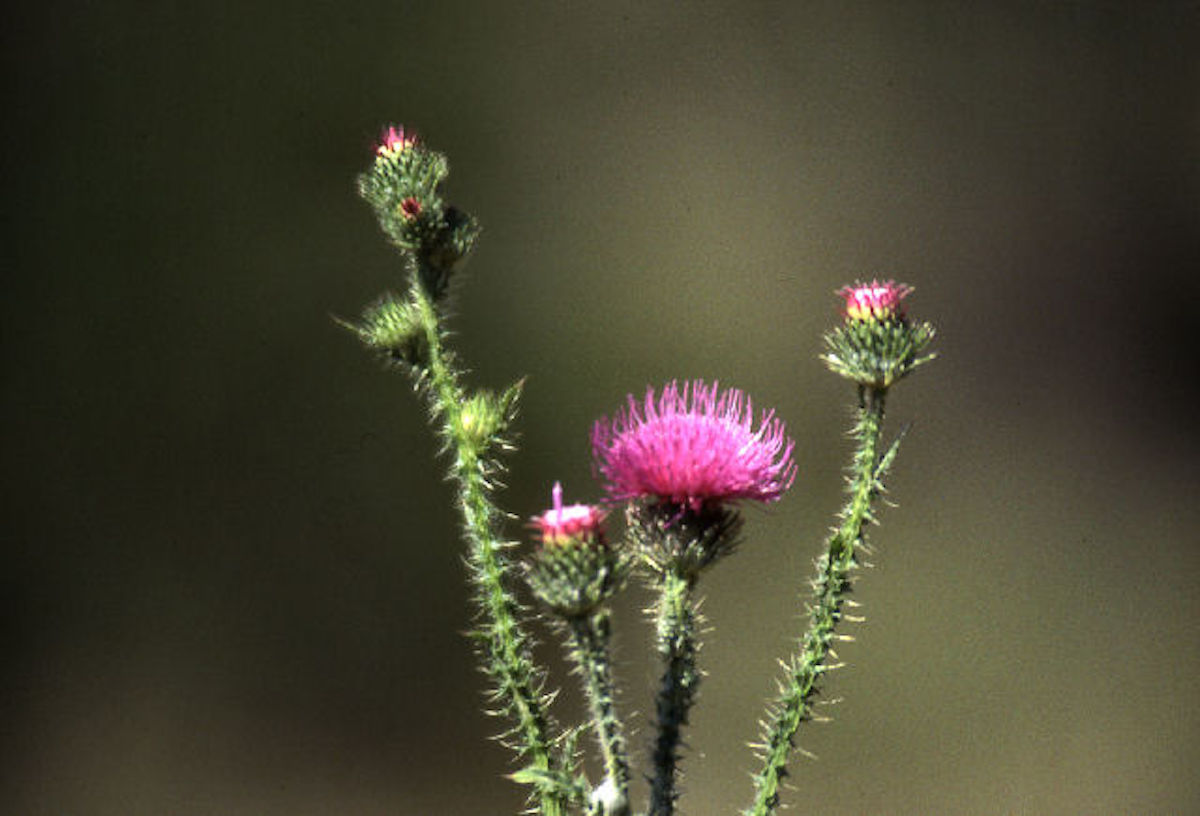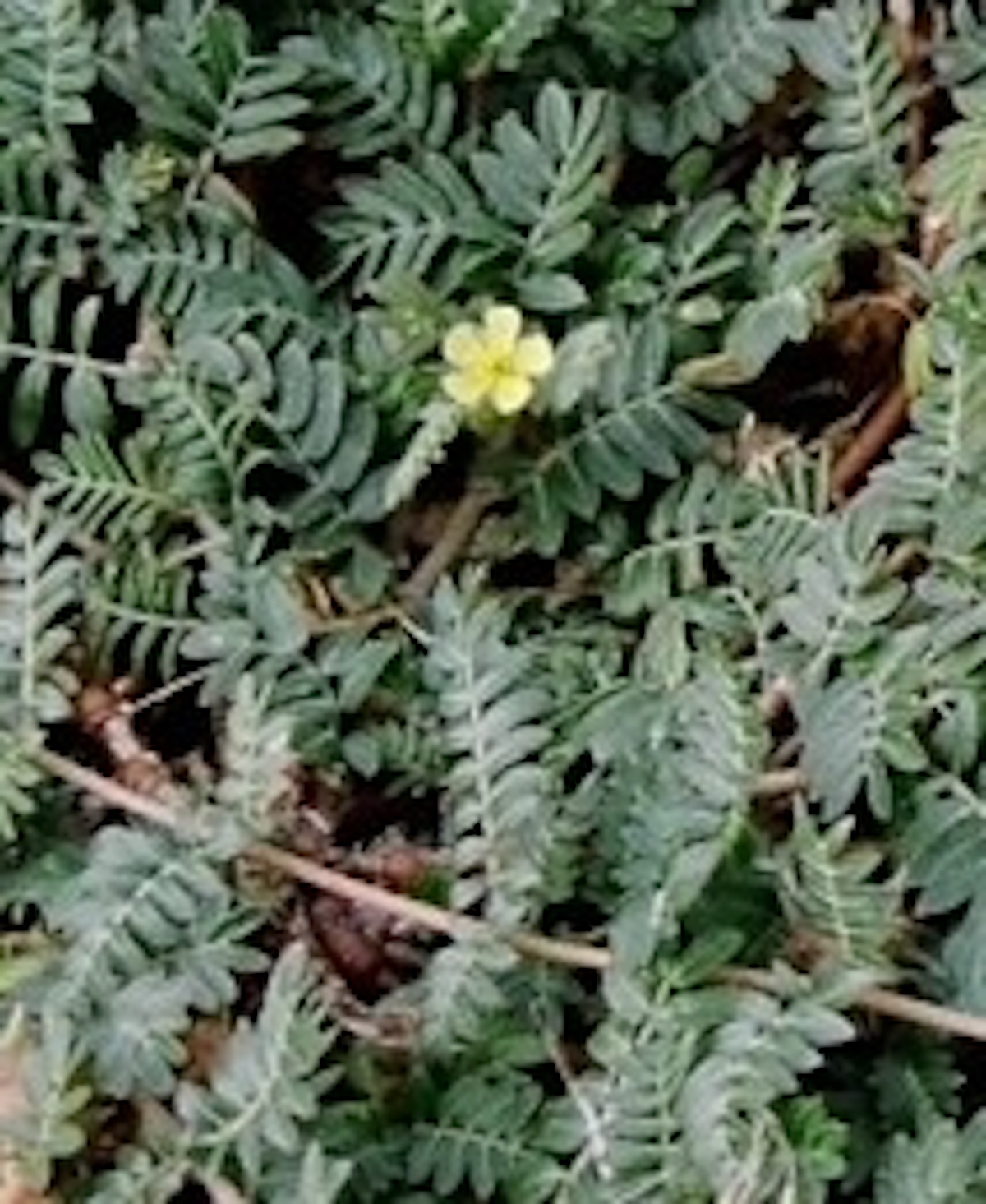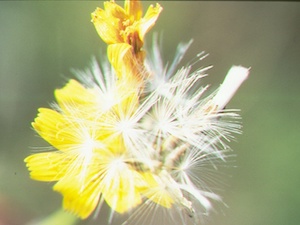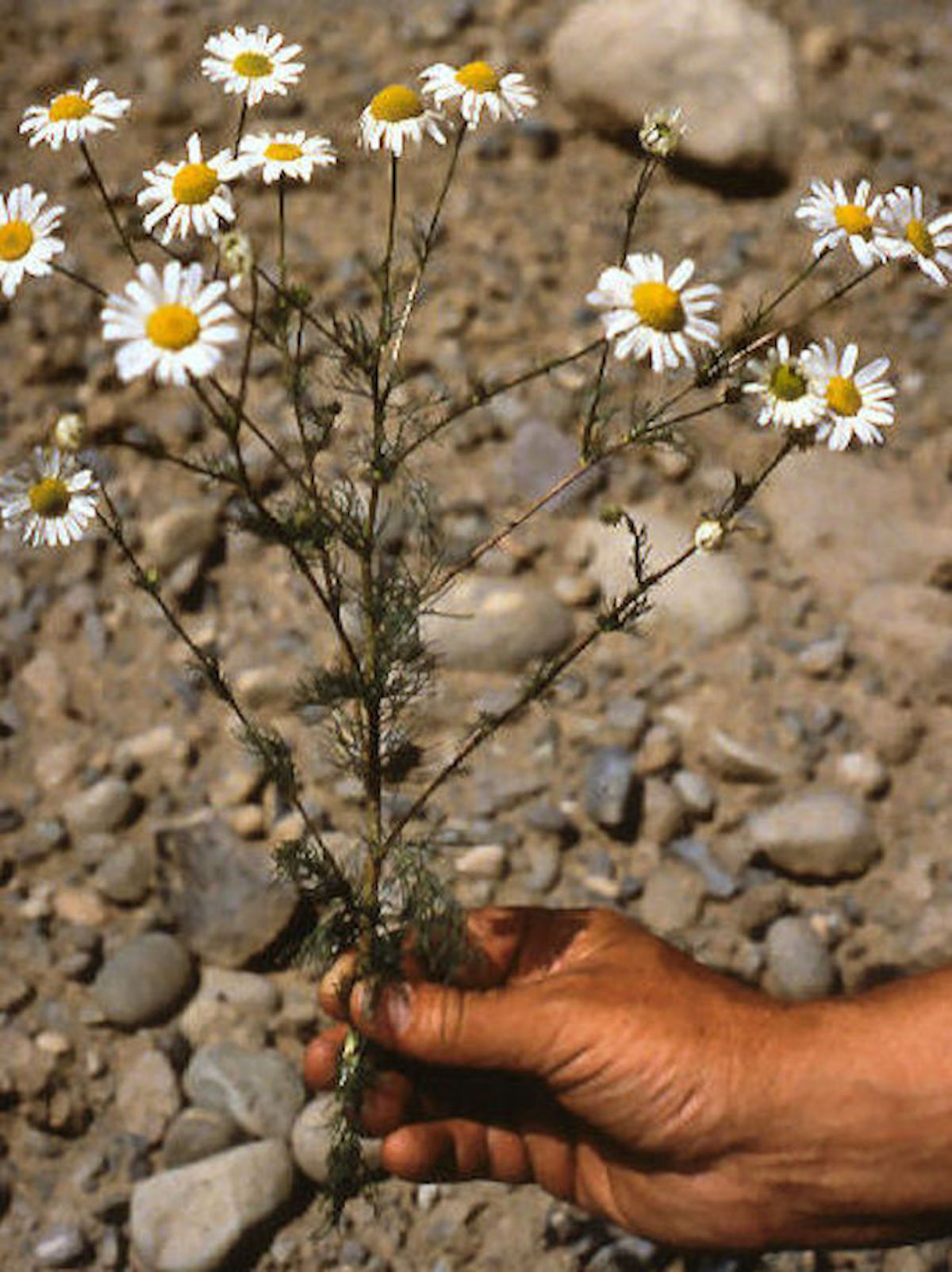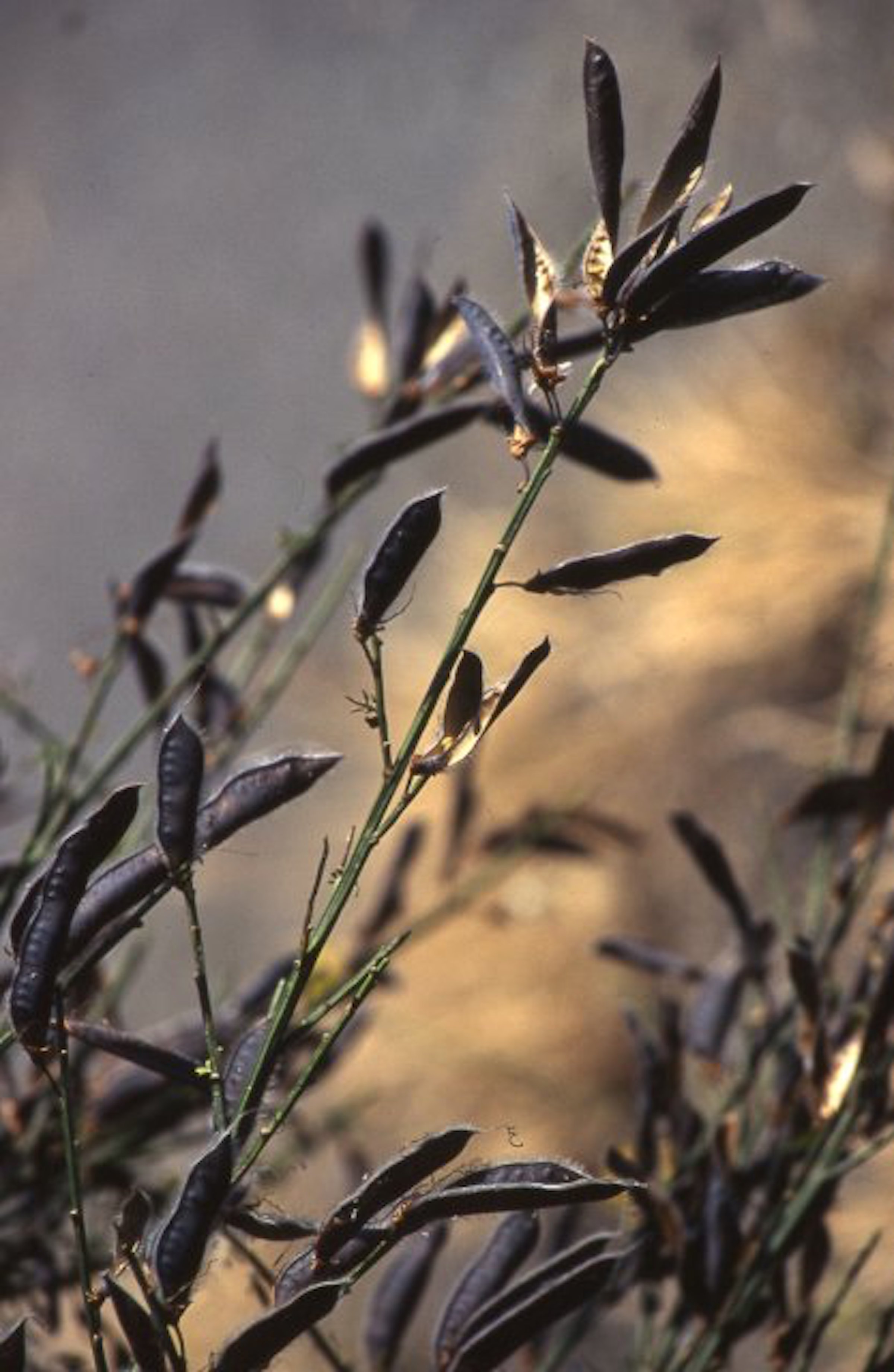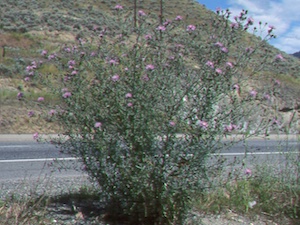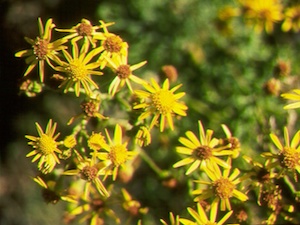Invasive plants with biocontrol
These invasive plants are species on which biological control agents have been released.
- Black knapweed is a perennial with branching stems growing 20 to 80 cm tall
- Plants reproduce from a woody root crown and lateral roots. Prostrate growing stems may develop roots at their nodes when they come in contact with moist soils
- Broad basal leaves have stalks and shallow lobes
- Stem leaves are clasping and progressively become smaller towards the top of the plant
- Rose to lavender coloured flowers appear from July to October
- The round, broad blooms are produced individually at stem tips and measure 1.3cm tall by 1cm wide
- Overlapping, fringed, comb to like bracts are dark brown or black and bare a likeness to ticks
- About 60 ivory, linear-striped seeds, 4mm long with short pappus are produced in each head
- Brown knapweed is a perennial that grows from a woody rootstock and reproduces strictly from seeds
- Plants grow 60 to 120 cm tall, with branching occurring towards the upper third of the plant
- Basal leaves are 15.2cm long x 4cm wide and are broadest in the middle and taper at both ends
- Lance shaped, clasping stem leaves gradually become smaller towards the top and have shallow lobes and fine-toothed or smooth margins
- Rose-purple coloured flowers appear from July to October, and are most abundant in August. On rare occasions the flowers can be white
- Broad, oval 2.5 cm flowers are produced singly at the top of branched stems
- Overlapping bracts are dark brown with broad, thin, papery margins that appear ragged or torn
- Light brown seeds that are 4mm long have lengthwise ridges or lines. Pappus appears small and scale-like
- A biennial, spreading by wind-borne seed. It forms a large, flat rosette with a long, fleshy tap root in the first year, and produces a 0.3 to 1.5m bolt in the second year
- The stems are spiny winged and slightly woolly
- Leaves are alternate, deeply lobed, with each lobe ending in a long sharp spine up to 1 cm long
- The upper leaf surface is deep green and has sharp prickles, while the lower surface is white with small white hairs
- Purple flower heads, 3.8 to 7.8cm in diameter, occur throughout the summer
- A biennial weed common in farmyards, along fencelines, roadsides, streambanks and idle areas
- Burdock is well known for its rounded flower heads with hooked spines that easily attach to clothing and animals
- Common burdock (arctium minus) grows 1 to 3m. in height, with hollow lower leaf stalks
- The flower heads are less than 2.5 cm across and are scattered along the stems
- Giant, or great burdock (arctium lappa) is similar in appearance but the lower leaf stalks are solid, and the flower heads are more than 2.5cm across and are arranged in a flat-topped cluster rather than along the stem
- A perennial, spreading by seeds and a horizontal creeping root system
- Stems are erect, up to 1.2m tall, with alternate leaves, 4 to 21cm long, divided into deep, irregular, spiny lobes
- The leaves are dark green and shiny on the surface with white hairs underneath
- Flowers form in clusters on small heads and are rose-purple, pink or sometimes white. Flowering occurs throughout the summer
- A perennial, spreading by seeds and creeping root stock
- Numerous light-green, smooth stems, 60 to 120cm tall, are produced on each plant
- Leaves are light green, heart shaped, and clasp the stem
- Roots are large, rough surfaced, and somewhat branching, and may extend 3m or more
- Buds appear from the lateral roots, producing new top growth at varying intervals
- Flowers, yellow tinged with orange, are snapdragon-shaped, and up to 4cm long
- A biennial to short-lived perennial, spreading primarily by seed dispersed with the movement of plant material
- Stems are 60 to 90cm in height with many branches
- Leaves are 5 to 20cm long, hairy, and highly divided. Leaves alternate from the stem, with basal leaves forming a rosette
- Flower heads are numerous, urn shaped, and covered with small, narrow bracts ending in sharp, rigid spines. Flowers are white or occasionally pink or purple
- Seeds are black to dark brown, 3mm long, and lack a developed fringe of hairs
- Diffuse knapweed contains volatile oils with a distinctive smell and extremely bitter taste
- Field bindweed is a perennial with branching prostrate stems reaching over 1m long
- It grows into a tangled dense groundcover mat or climbs over anything in its vicinity. It reproduces by seed and root buds
- It has an extensive cord-like root system with a tap root that can penetrate 5m into soils
- Leaves are variable in size, arrowhead-shaped with pointed blunt lobes at the base. The stalked leaves are arranged alternately along counter-clockwise twining stems
- Trumpet or bell-shaped, white and pink flowers measuring 2.5cm in diameter appear from June to September. The stalked flowers can be solitary or in groups of two to four
- The seedpods have two chambers that contain up to four smooth, 3mm pear shaped seeds, which can remain viable for 50 years
- Gorse is a spiny evergreen shrub with a single upright stem, spine-like leaves, and fragrant yellow, pea-like flowers
- It thrives on sunny clearings with dry, infertile soil such as sandy or rocky areas, roadsides, fields and pastures, bluffs, etc.
- Seedpods are hairy and black. Maturing seedpods explode and disperse up to 18,000 seeds per mature plant. Gorse seeds are easily distributed by ants, birds and other animals, as well as by machinery
- Gorse can grow 1 to 3m in height at maturity. It grows rapidly for the first 15 years and can live up to 45 years
- Dense patches can hinder revegetation of harvested areas and recreational use of land
- Gorse can increase fire hazard as plants contain volatile oils and produce large amounts of litter
- Gorse displaces native vegetation, decreasing forage for wildlife and local plant biodiversity. It is known on Vancouver Island, in West Vancouver, some of the Gulf Islands, and Haida Gwaii
- Hedge bindweed is a unique type of annual (clonal pseudo-annual) and, therefore, is often referred to as a perennial
- The parent plant dies in the fall. Prior to dying it produces rhizomes and seeds that overwinter
- Rhizomatous roots are elongated, but, lack underground stolons. The stems twine, trail or climb to 3 m. Plants in the Convolvulaceae family always twine from right to left, which is opposite the course of the sun
- Leaves are heart- or arrow-shaped with rounded or angled (not pointed) basal lobes. Leaves attach to the stem with long stalks in an alternate arrangement. The leaves are delicate and thin textured, measuring 5 to 10cm long and 2.5 to 5cm wide
- Solitary flowers are borne on square stalks from within the leaf axils. The showy white to deep pink, trumpet shaped flowers are present from July to September, and measure 4 to 7cm long
- The flowers fully expand during sunny days, but, stay closed during dull weather
- Seeds are produced in 1cm long capsules which split when mature. Each capsule contains two to four seeds, each measuring 5mm long. The seeds are slightly roughened and can be dull gray, brown or black coloured
- Hedge bindweed is intolerant of shade
- Worldwide there are 25 Calystegia species. Two species are native to Canada. In the United States, 16 of their 17 species are native. The plants morphology is not clear, but, it is known to readily hybridize. The geographic distributions of the plant species merge and overlap, making it difficult to divide the subspecies
- A biennial or short-lived perennial, spreading mainly by seed
- Germination of seeds is almost completely restricted to the spring
- A basal rosette of leaves forms in the summer and the autumn. The size of the rosette determines further development. Those larger than 30 cm in diameter bolt and flower from May to July of the following year. The inflorescence has up to 23 red-purple flowers
- An individual plant can produce up to 4000 large seeds (burs) covered with barbed spines which can be dispersed by animals
- Spines are a source of annoyance for wildlife and livestock, which get the burs caught in their hair and fur
- Seeds and plant material are toxic to livestock
- A perennial, spreading by seeds and buds on persistent, creeping roots
- Stems are erect, 1m tall and hairless or with only a few hairs near the top
- Plants grow in clumps forming dense and extensive stands
- Stalk-less leaves, 3 to 7cm long and less than 5mm wide, alternate one per node
- A whorl of leaves marks the start of the flowering portion of the stem
- Flower bracts, about 1cm wide and 1.2cm long with a sharp point, occur in pairs on flowering stems
- Flowers lack petals and sepals, and are clustered with a pair of surrounding bracts such that the group resembles a single flower
- Seeds are about 2 mm long, smooth, grey to yellow or brown and usually have a yellow bump near the base. Three seeds are produced per cluster
- All parts of the plant contain a milky-coloured latex juice that can poison livestock and cause skin irritation on humans
- A fibrous rooted, biennial herb growing 0.2 to 2.0m tall
- Stems are erect, slender, ribbed and sometimes with ascending branches. Strongly spiny-winged from the winged leaf bases. Basal and lower stem leaves are narrowly elliptic. Middle stem leaves and reduced upper ones are lance shaped and lobed to about half the width of the leaf, with narrow, spine-tipped segments and winged bases
- Leaves are nearly hairless to lightly, soft hairy on the upper surface, and lightly to densely long-hairy below
- Flower heads are disc-shaped, compact purple clusters terminating the stem or at the ends of branches
- Bracts are cobwebby and often sticky
- Seeds are 2.5 to 3.5mm long, 1mm wide, straw-coloured to almost white with a fringe of hairs 9 to 10mm long
- Seeds germinate in early spring (can also germinate as late as October) and rosettes begin vigorous growth, filling in the surrounding area by summer
- Their numerous leaves form disks that eliminate other species by pressure and shading
- Flowering and fruiting occurs the following year, and mature individuals die
- There could be confusion in identifying marsh thistle from bull thistle
- Meadow knapweed is a deep rooted perennial that reproduces mainly by seed
- Established plants have a woody crown with clusters of fleshy roots
- Seedlings begin with a tap root. Mature plants reach over 1m tall, with few to several branching stems
- Basal leaves can reach 15cm long, tapering at either end, the broadest point in the middle
- Stem leaves are clasping, have shallow lobes and are narrower than basal leaves, appearing somewhat lance shaped
- Globe shaped rose-purple flowers, (and occasionally white), 1.3 cm in diameter are produced at the tips of the upper branches and appear from July to September
- The bracts are light or dark brown with fringed margins and may appear reflective with a golden sheen during flowering
- Meadow knapweed seeds are pale tan, 2mm long and plumeless. Seeds often have a row of short hairs
- The plant establishes in moist habitats and cool climates in forest openings and near rivers and streams
- Meadow knapweed is a fertile hybrid of black and brown knapweeds and plants can closely resemble either parent in a stand
- The hawkweed genus hieracium is divided into three subgenera: pilosella, hieracium and chinonoracium
- Mouse-ear hawkweed is in the pilosella group which is comprised of invasive hawkweeds found in the Pacific Northwest
- Mouse-ear hawkweed is a perennial that reproduces by stolons, rhizomes and seeds
- Mouse-ear hawkweed plants produce numerous leafy, mat-forming reddish coloured stolons that measure 5 to 25 cm long. The leafy stolons become elongated in the summer and produce daughter rosettes at the stolon tips in as little as seven weeks
- Leaves are restricted to the basal part of the plant and are egg-shaped with narrow bases. Both sides of the leaf are hairy, the upper leaf surface is dark green coloured with numerous long hairs, whereas the lower leaf surface appears whitish due to the dense mat of short hairs
- The bolting stems are erect and un-branching, are hairy at their bases and reach a height of 15 to 30 cm tall
- Mouse-ear hawkweed is the only yellow flowering hawkweed that produces a single (rarely two) flower. The flower is borne at the top of the stem and measures 1.3 to 2cm in diameter
- Seeds are produced asexually, however, recent studies indicate cross pollination is quite common. Each hawkweed flower can produce 12 to 30 small black ribbed seeds (achenes). The seeds are narrower at their base, measure 1.5 to 2 mm long and have a tawny coloured pappus. Hawkweed seeds can remain viable in the soil for up to seven years. An entire generation can take only four months to complete. Seeds generally are not carried great distances by wind and often fall to the soil within an existing infestation, thus contributing to increasing the size and density of established locations, whereas new infestations occur when the ribbed seeds become attached to fur, feathers, clothing or vehicles and are carried to new sites
- Hawkweeds die back over the winter and regenerate each year from their underground rhizomes
A herbaceous perennial, or occasionally a winter annual, spreading primarily from wind-dispersed seed. It forms a large rosette in the first year, then produces flowering bolts, 0.2 to 2.4 m tall, with long, fleshy tap roots in the second growth stage. One to seven erect, highly branched stems form; stems have spiny wings except immediately below the flower head. Leaves in the basal rosette are elliptic to lance-shaped, 15 to 30 cm long, and pinnately lobed, with each lobe ending in a spine. Leaves range from hairless to densely pubescent. Leaves on the stem are similar but smaller, without lobes, and alternate on the stem. Solitary flower heads, 1.5 to 4.5 cm in diameter, occur at the ends of branches, usually drooping over (hence "nodding" thistle). Flowers are tubular, pink to purple (occasionally white) in colour. Flowering occurs from July to September.
- Also known as "the devil's paintbrush", orange hawkweed is a perennial with vibrant orange flowers, clustered at the top of stems which are covered in stiff black hairs
- The long and oval-shaped leaves cluster at the base of the fibrous stems
- The plant contains a milky juice and can grow up to 60cm tall
- Orange hawkweed grows at low- to mid-elevations, usually in open areas such as pastures, meadows, clearings, roadsides, and disturbed sites. It replaces forage plants on pastures, outcompeting all other vegetatation
- Spread very rapidly by seed, stolons (above-ground runners) and root segments, it can form near-monocultures
- Orange hawkweed is considered a major concern in the Kootenay, Okanagan, Thompson, Cariboo, Omineca, and Peace agricultural regions
- Perennial sow-thistle is a herbaceous perennial that reproduces from seed and from an extensive creeping root system
- The roots penetrate down to 3m, but, most of the system is within the top 5 to 15 cm of soil. Roots break easily and regenerate from buds
- Hollow, erect stems can reach 0.6 to 1.5 m tall and contain a bitter, milky juice
- Stems are non-branching until near the top
- A variety of leaf shapes and sizes are arranged alternately along the stem. Upper leaves are clasping while the lower leaves narrow to a winged stalk
- All leaves have deep lobes and weak prickles along their margins. Bright yellow blossoms appear in June and continue into September. At peak bloom, each flower can reach 3.8 cm across. A single plant can have as many as 20 flower heads, but, few come into flower at the same time
- It is a prolific seed producer with about 10,000 seeds produced per flowering stem. The ribbed seeds have attached pappus which assists with their distribution
- An annual, winter annual, or biennial spread by seeds
- Plants are 20 to 150 cm tall, generally smooth or with scattered hairs on stems and leaves
- The upper stem is branched, with spiny wings extending to the flower heads
- Mature plants have a well-developed basal rosette of narrow, oblong to elliptic leaves, deeply lobed. The lobes have one to three points, with each point ending in a spine
- Solitary flower heads, 1.2 to 1.6cm in diameter, form at the end of stems or in clusters on young branches
- Flowers are usually purple, but some are white or cream coloured
- Seeds are 2.5 to 3 mm long, and light brown at maturity
- Puncturevine is a herbaceous annual that reproduces by seed
- Trailing prostrate stems branch from the central crown, forming a dense mat up to 2 m across. Stems are green and often tinged reddish brown. The pinnately compound leaves grow in opposite pairs along the stem. The entire plant is covered with hairs
- Its taproot and network of fine rootlets enable it to withstand extreme drought
- Bright yellow flowers are produced in leaf axils and appear from June to September. The 1cm flowers have five petals, appearing similar to buttercup blooms
- Seeds are contained within a circular, spiny "bur-like" seedpod that breaks apart when mature. The pod has five sections, each with a chamber containing two to four seeds. Seeds can remain dormant in soil for up to five years
- The pods outer coat has two stout, sharp spines capable of puncturing bicycle tires and footwear. It is reported to be poisonous to animals causing photosensitivity, however, it is more likely to pose a threat through injury caused from the spiny seedpods
- Also known as goathead, Mexican sandbur, Texas sandbur
- A perennial wetland plant, spreading by seed and root stock
- Floating seedlings are the main mode of dispersal. Seeds can remain viable in the soil for several years
- Mature plants range between 0.5 to 2m high, with a maximum of 30 to 50 shoots emerging from a common root stock
- Three forms of purple flowers are produced prolifically throughout the summer, occurring in equal frequency
- The profuse, showy flowers have given rise to the plant's use as a garden ornamental
- A tap-rooted herbaceous perennial, spreading by rhizomatous lateral roots and prolific seed production. Plants range from 0.3 to 1.3m in height at maturity
- Rosettes develop from root buds in fall
- Fosette leaves are lance shaped, deeply lobed 1 to 3cm wide and 5 to 12cm long
- Leaves develop a reddish tinge near the tips during the winter. Multi-branched, erect stems grow from the root crown in the spring
- Stems are pale green, slender, sparsely leafed, and smooth except for erect, downward-pointing hairs on the lower 5 to 10 cm. Flower heads develop along or at the ends of stems, individually or in groups of two to five
- Each flower head may contain 10 to 12 bright yellow flowers. Flowering occurs from mid-summer until the first frosts
- Stems die back each year
- A perennial herb spreading by seeds and creeping horizontal roots
- Roots are dark brown or black, scaly, and produce stem buds that develop into leafy shoots
- Stems are highly branched, erect, 2 to 10 cm high, thin and stiff. Young stems are covered with soft grey hairs. Stem leaves have smooth margins and alternate on the stem
- Rosette leaves are oblong to lance shaped, with irregular pinnate lobes (sometimes smooth), 5 to 10cm long, and 1 to 2.5cm wide
- Solitary flower heads, 15 to 17mm in diameter, are surrounded by bracts 12 to 14mm long
- Flower heads are oval, greenish at the base with a papery, finely haired tip
- Plants produce numerous tubular flowers, 10 to 13mm long, pink or purple, becoming straw-coloured at maturity
- Flowering occurs from July to September
- Seeds are 2 to 3 mm, grey or ivory in colour, surrounded by a white, deciduous fringe of hairs (pappus) 1cm long
- Scentless chamomile is an annual or short-lived perennial that reproduces from seed
- Plants grow 15 to 100cm tall, rising from a fibrous taproot
- Stem leaves are arranged alternately and are finely divided, giving the plant an overall fern-like appearance
- White, daisy-like flowers, 18 to 30 mm in diameter, develop singly at the end of long branches. The floral period starts in mid June and lasts into September
- Seeds are 2mm long, dark brown, with three ribs on one side and two merging dark lines on the other. Pappus is minute or absent
- These plants are prolific seed producers, each capable of producing 10,000 to 200,000 seeds
- Often confused with ox-eye daisy and stinking mayweed
- Scotch broom is a perennial, evergreen shrub that reproduces by seed
- Mature height is 1 to 3 m tall with stiff angled, somewhat erect, dark green branches creating an irregular shape
- Many of the branches are leafless or have few leaves. Upper leaves are simple (single) while lower are trifoliate (three parts)
- Forked tap roots enable it to anchor in rocky shorelines and steep slopes
- Bright yellow 2.0 cm pea-like flowers appear from early April through June
- Up to eight brown seeds, 2 to 3 mm long with shiny coats, develop within brown-black pods with hairy margins. In the soil, seeds can remain viable for 60 years or more
- Scotch broom spreads rapidly in an open canopy along right-of-ways, trails and near streams
- It is drought tolerant, preferring infertile or rocky soils and is well adapted to windy seashore conditions
- All parts of the plant contain small amounts of toxic alkaloids capable of poisoning livestock when consumed
- As with all plants in the fabaceae family, it fixes nitrogen, however, the nitrogen does not become available until after the plant dies
- A short-lived perennial, spreading mainly by seed
- Mature plants are 0.3 to 1.5 m tall, with long, fibrous tap roots
- Stems are somewhat hairy when young and highly branched. The basal and lower stem leaves are pinnately lobed
- The upper leaves have smooth margins. Young leaves have a fine coating of hairs
- Flowers are 1 to 1.5 cm long, pink to purple. Bracts of the flower head are black tipped, giving the head a spotted appearance. Flowering occurs from July through to September
- Seeds are black or brown, 3mm long, and topped with bristles up to half the length of the seed
- The plant contains volatile oils with a distinctive smell and an extremely bitter taste
- A perennial spreading by seeds or short runners
- Stems growing to 1m high, are numerous, erect, and rust coloured at the base
- Leaves are opposite, oval, and attached directly to the stem; they appear to be perforated with many tiny translucent dots, visible when held up to a light source
- Flowering begins in early summer. Flowers are yellow with five separate petals and numerous stamens arranged in three groups
- Rust-brown seed pods, containing numerous seeds, mature in late summer to early autumn
- Germination occurs in the spring
- St. John's wort contains a toxin which, in light-coloured livestock that feed on it, induces photosensitization (skin is irritated and blisters when exposed to sunlight)
- A biennial to short-lived perennial, spreading by prolific seed production (in excess of 150,000 seeds per plant)
- A low-growing rosette of leaves is produced in the first year
- Erect stems, 0.3 to 1.2 m high, are produced in the second and subsequent years
- The dark green, stalk-less leaves are deeply lobed into irregular segments, giving the plant a "ragged" appearance
- The daisy-like, bright yellow flowers are in bloom from July through September
- Tansy ragwort is poisonous to livestock. Cattle and horses are most seriously affected, while sheep are seldom affected
- The hawkweed genus hieracium is divided into three subgenera: pilosella, hieracium and chinonoracium
- Whiplash hawkweed is in the pilosella group which is comprised of invasive hawkweeds found in the Pacific Northwest
- Whiplash hawkweed is a stable hybrid of mouse-ear and meadow hawkweeds
- Whiplash hawkweed is a perennial with fibrous and stout rhizomatous roots
- At maturity the plant can range from 6 to 20 cm tall
- Leaves are mostly basal and are lanceolate to spoon shaped with a narrow-stalked base. The basal leaves measure 3 to 13 cm long by 0.5 to 2.5cm wide. The upper leaf surface is dark green and covered with long simple hairs. The lower leaf surface is lighter green and has moderately more hairs than the upper surface. The leaf hairs are both simple and star-like
- Stems can occur in multiples, are upright and branching, and are covered with star-like hairs. Stem leaves are rare, however, it is possible for a single reduced stem leaf to be present. The stems exude milky latex when they are cut or broken.
- One to six yellow flowers develop on long stalks and the floral bracts have many glandular and star-like hairs. Each hawkweed flower can produce 12 to 30 small black ribbed seeds (achenes)
- The seeds measure 1.5 to 2.0 mm long and have dirty white pappus present. Whiplash hawkweed reproduces from seeds and stolons. The leafy stolons become elongated in the summer and produce daughter rosettes at the stolon tips. Hawkweed seeds can remain viable in the soil for up to seven years. An entire generation can take only four months to complete
- Hawkweeds die back over the winter and regenerate each year from their underground rhizomes
- Seeds are generally are not carried great distances by wind and often fall to the soil within an existing infestation, thus contributing to increasing the size and density of established locations, whereas new infestations occur when the ribbed seeds become attached to fur, feathers, clothing or vehicles and are carried to new sites
- A perennial, spreading by creeping roots and seeds
- Stems, growing up to 80 cm high, are hairless and usually un-branched
- Leaves are numerous, one per node, essentially stalk-less, and 2 to 10 cm long by 1 to 5 mm wide. The leaves are also hairless and usually narrowed towards the base
- Bright yellow "snapdragon" flowers are 2 to 3.5cm long on stalks about 5mm long



